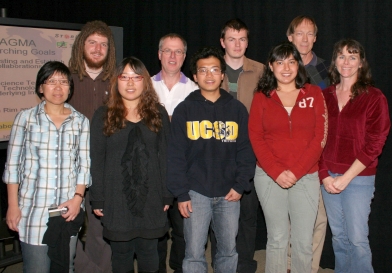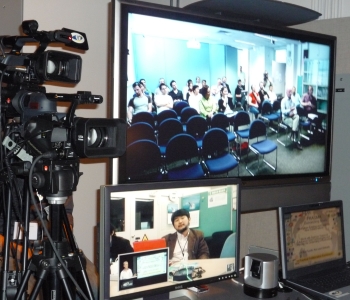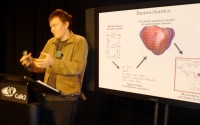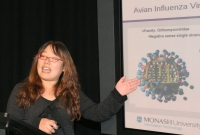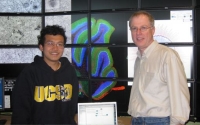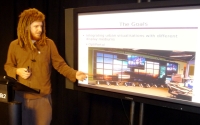Australian Students Present Cyberinfrastructure Research Via Tri-Continental High-Def Teleconference
|
San Diego, CA, March 6, 2009 — Four Monash University Faculty of Information Technology undergraduates have just completed their eight-week research experiences at UC San Diego. They gave presentations from the UCSD division of the California Institute for Telecommunications and Information Technology's (Calit2's) high-definition (HD) studio on Monday, February 23 at 4:00 p.m. during a live HD video teleconference back to Australia (11 a.m. the next morning down under) and in a regular streaming feed to Japan's National Institute for Information and Communications Technology (9 a.m. the next morning in Tokyo). Live video of the audiences in both locations was streamed back to the studio.
The interactive set-up enabled the students to present their research projects to both their Monash and UC San Diego mentors simultaneously, as well as to interested research partners in Japan. Their UCSD mentors included researchers affiliated with Calit2 and the San Diego Supercomputer Center (SDSC).
Nicholas Barnes, Guanghua (Aimee) Li, Hoang Anh Nguyen and Peter Serwylo are the first class of students to come to UC San Diego to do a summer (winter quarter here) of research under a new initiative at Monash: Monash Undergraduate Research Projects Abroad (MURPA).
MURPA is modeled on UCSD's highly successful Pacific Rim Experiences for Undergraduates (PRIME) program which provides UCSD undergraduates with the unique opportunity of doing real research while living in one of several Pacific Rim countries for the summer, working with mentors at both the host institution and at UCSD.
|
"We call MURPA inverse PRIME," joked David Abramson, director of Monash University's eScience and Grid Engineering Lab. "We've been involved in PRIME since it first started, hosting projects across a wide range of subjects. PRIME fits perfectly with Monash's vision and commitment to internationalization. We decided to do basically the same, but with a few tweaks. MURPA provides another spoke to our internationalization strategy. Everyone's very excited about it; it has high level attention.
"One thing we did differently is that we introduced a seminar by HD video conference series," continued Abramson, "Researchers from UCSD have given seminars to both the faculty and the students at Monash. These are research seminars, but adjusted so that students get something out of it as well. It exposes them to some of the options for their projects. In fact, all the potential mentors for this year gave seminars, which is fantastic." Larry Smarr, director of Calit2, also gave a seminar this year.
"It is great to be able to reciprocate after having so many PRIME students go to Monash over the last six years," noted Peter Arzberger, coinvestigator of PRIME. Seven UCSD students went to Monash last year.
"All of the projects in one way or another touched on projects affiliated with Calit2 or SDSC," Arzberger pointed out, "MURPA allowed students to learn more about the range of activities at Calit2, SDSC and, more broadly, UCSD. This helps build up the collaborations between our institutions."
Nicholas Barnes worked with Andrew McCulloch, Roy Kerckhoffs and Fred Lionetti in McCulloch's Cardiac Mechanics Research Group on a research project involving three-dimensional hyperelastic problems in biomechanics and their solution by separately subdividing contiguous subregions of 3-D meshes and solving the resulting separate data parallel problems. Barnes has been largely compiling and running various solvers on different platforms and benchmarking them. The overall goal is to develop and test a partition of unity method for parallel computation of biomechanics problems in the software package, Continuity.
|
About the project and MURPA's first year, McCulloch said, "It has been fun and productive. Nick is doing great." McCulloch is a professor and the chair of UCSD's Department of Bioengineering.
Guanghua (Aimee) Li worked with Wilfred Li, the executive director of the National Biomedical Computation Resource (NBCR) on a project involving virtual screening for inhibitors against avian flu. She used cheminformatics and data mining techniques to optimize novel inhibitors against avian influenza neuraminidase N1, which is responsible for the release of newly synthesized viral particles from a host cell membrane surface. She is also incorporating different analysis tools into a work flow using the Opal web service toolkit. These small molecule inhibitors complement the vaccine development effort against the influenza virus; both are important in the fight against the threat of a pandemic flu outbreak.
|
"Aimee is a very hard worker," said Wilfred Li, "As a computer science major, she of course didn´t have much chemistry and biology background on molecular descriptors, proteins and ligands, etc., and had not done much research before. But now, she is a “seasoned’ young researcher, raising critical questions and designing appropriate computational experiments to get the answers."
It is a small world, after all. Aimee Li and Wilfred Li are not related, but it turns out that they not only share the same home province in China, but also went to different campuses of the same university (Jiaotong University). "So, we are alumni in some sense," said Wilfred Li, "Of course, this was unknown to us until we actually met for the first time here at Calit2."
Unlike the other three students Aimee did not leave for home last weekend. She is taking classes at UCSD and will leave at the end of the quarter (mid-March).
Hoang Anh Nguyen worked with Ilkay Altintas, deputy coordinator for Research, Cyberinfrastructure Research, Education and Development (CI-RED) at SDSC, on a software engineering project involving parameterized simulation over a distributed network of computers managed by the Nimrod software package combined with the scientific work flow manager, Kepler. The primary goal was to implement a user-friendly graphical user interface that displays results on an Optiportal and other display devices and provides a tool for users to interact with Nimrod/K via Optiportal; this functionality is not currently available.
|
Nguyen successfully built code to go between Kepler work flows and the Optiportal and is now able to show some things on the Optiportal. He will continue working on the project back at Monash for his honors year research project with his Monash mentor, Abramson. His timing is excellent because Abramson's lab has a project between Monash and Leica Microsystems in Germany which will be launching in mid March. One of their goals is to show data streaming off of a microscope and appearing on the Optiportal. They are planning on using this early work.
"MURPA has been a great experience for me and my group," noted SDSC's Altintas, "Hoang Nguyen was able to integrate into the group and bring a fresh view to group discussions quite rapidly. It was also nice to see that what he developed was instantly useful to one of our projects. We had a great time sharing our expertise with Hoang."
Peter Serwylo worked with Calit2 project scientist, Jürgen Schulze, on a visualization project, largely of his own design, involving 3-D city models as used in many disciplines such as advertising, planning, simulations and games. Serwylo worked on developing a way to generate these models in a timely manner with minimal human input.
"I was impressed with Peter´s self-motivation and productivity," said Schulze, "He quickly learned how to use our virtual reality software system, and implemented his ideas in C++ code to try them out. The result was an interactive application which allows a user to manually select a building on an aerial map and then Peter's algorithm will take over and figure out the exact outline of the building, as well as its 3-D geometry."
|
Unlike the other students, Serwylo is already half way through his honors project. He took the work he was doing and adapted it to work with the open scene graph library as part of Covise, which means that it can now be moved to the Optiportal fairly easily. "This is a good example of taking something already well advanced," pointed out Abramson, "That otherwise would not have gone a certain direction without the expertise here at UCSD. It's not that we don't have people working on these projects at Monash, it's a different angle."
The exchange of expertise works both ways. "Now I am hoping to get a PRIME student for the summer to go to Peter´s lab in Monash," Calit2's Schulze added, "And integrate his 3-D building algorithms into our virtual reality software framework."
Shinji Shimojo, Sakai Morinobu and Taku Noguchi participated in the HD VTC from the National Institute for Information and Communications Technology (NiCT) in Japan. NiCT is a new PRIME program host site, their research areas are visualization projects and next generation networking.
After the seminar presentations were concluded, Ronald Pose, one of many in the audience at Monash, sent an email in which he stated: "a big thank you for everyone who has put a great deal of effort into making this inaugural MURPA student experience so successful. I look forward to talking to the students next week in Australia, and having them convey their enthusiasm to the next generation of MURPA students." Pose, from the Faculty of IT @ Monash, was the MURPA director for 2008.
MURPA had pilot funding from the Monash Office of the Deputy Vice Chancellor (International), the Monash eResearch Centre (MeRC), the Faculty of Information Technology and Monash Abroad for this year (2008); a similar approach is happening for a second year, 2009.
"It's been great. I think it's been a successful first time around because we learned a lot from PRIME," said Monash's Abramson, "It's a very exciting program, we are delighted and we'll keep doing it.
"The thing I love is working with bright young students," Abramson continued, "It's just so refreshing to watch them growing and track their careers."
PRIME is funded by the National Science Foundation with additional support from Calit2, NBCR, and the Telemedicine and Advanced Technology Research Center. Gabriele Wienhausen, the associate dean of education for the UC San Diego division of Biological Sciences, is the principal investigator of PRIME.
PRIME leverages the scientific community built by the Pacific Rim Application and Grid Middleware Assembly (PRAGMA) project. PRAGMA is a group of leading Pacific Rim research organizations collaborating on advancing grid technology applications. The majority of the PRIME host institutions are members of PRAGMA. Monash is an original PRAGMA collaborator. Arzberger is the chair and principal investigator of PRAGMA.
NiCT's Shimojo is also associated with Osaka University, a long-time PRAGMA partner and PRIME host institution from the beginning of the program. The first spin-off of PRIME was created at Osaka: PRIUS - Pacific Rim International UniverSity. They adapted PRIME into a program for graduate students that includes a course on international integrated science in addition to the internship experience. The course is a series of lectures, taught mainly by members of the PRAGMA community. PRIUS is funded by Japan's Ministry of Education, Culture, Sports, Science and Technology. It provided further inspiration for MURPA.
"Both the MURPA and PRIME students are learning far more than the specific science or technology around their science," concluded Arzberger, "They are learning about working in a multidisciplinary, multicultural team of researchers."
Related Links
MURPA
David Abramson's Monash eScience and Grid Engineering Lab
PRIME
Monash University, Melbourne, Australia
PRIUS - Pacific Rim International UniverSity
Pacific Rim Application and Grid Middleware Assembly (PRAGMA

